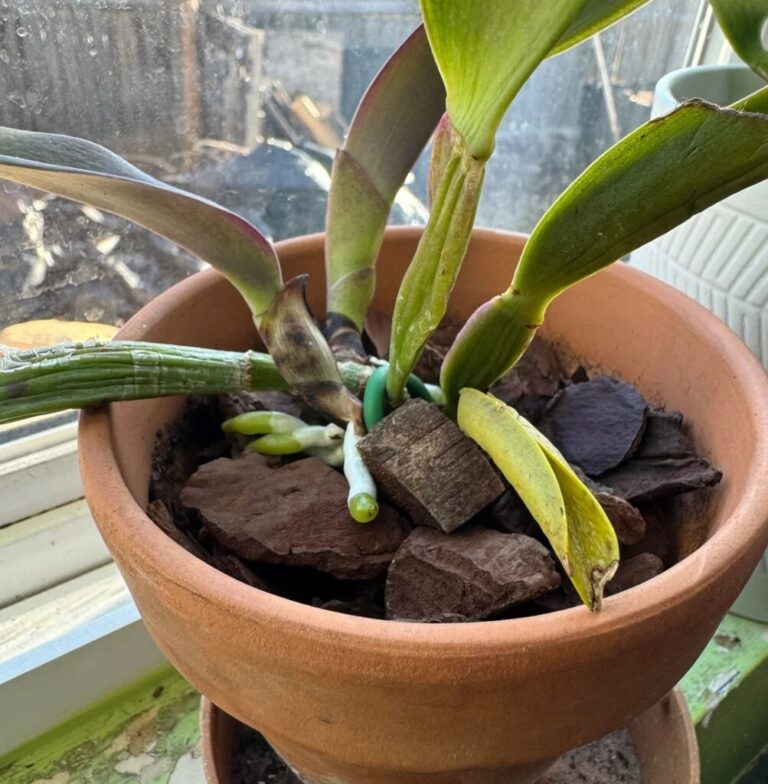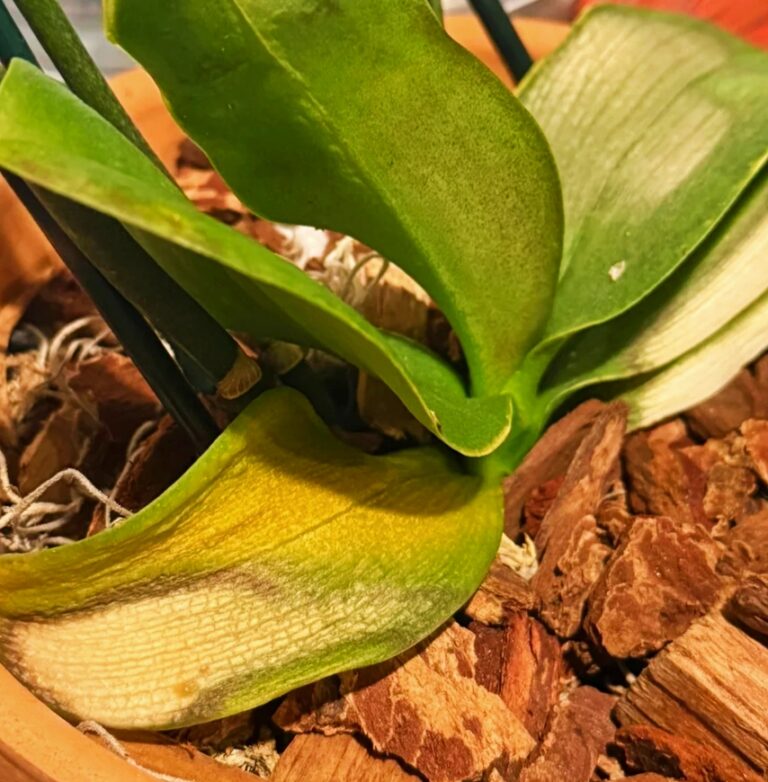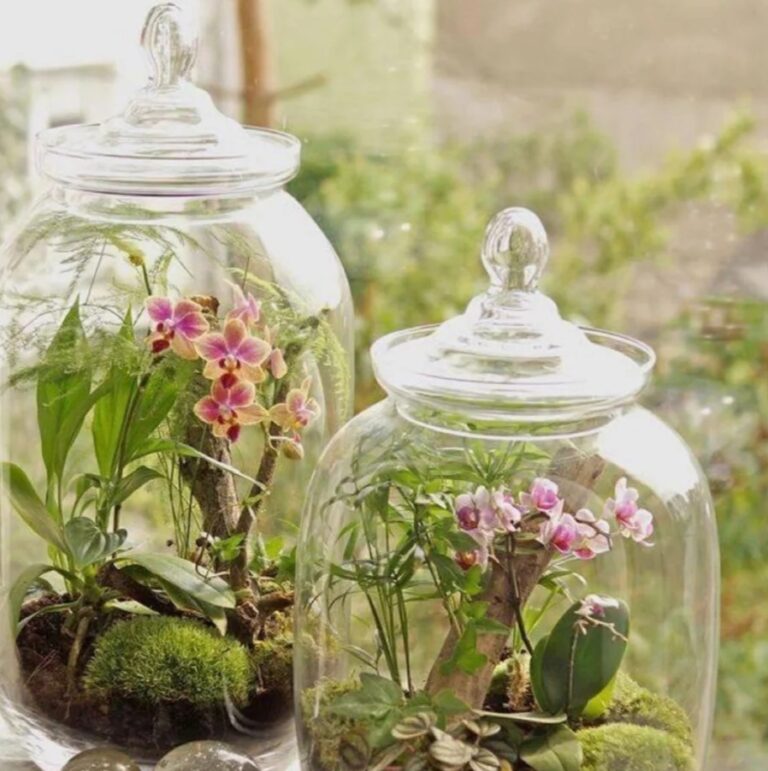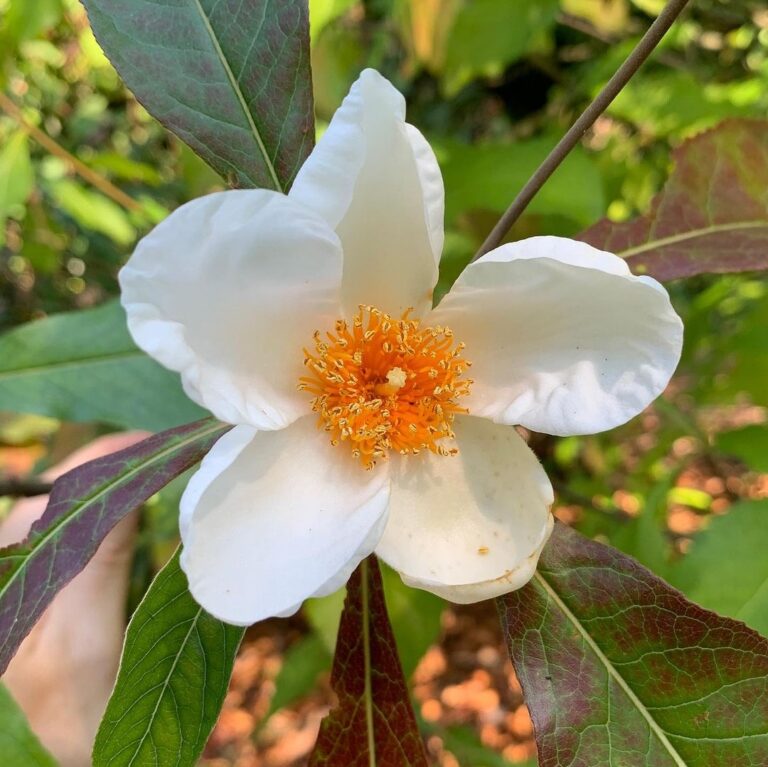Phalaenopsis finleyi, formerly known as Kingidium decumbens, is a rare and fascinating miniature orchid species that stands out due to its compact growth, distinctive creeping habit, and beautifully fragrant flowers. Native to the warm, humid forests of Thailand, Myanmar, and Laos, this epiphytic orchid thrives in its natural habitat by attaching itself to tree branches and absorbing nutrients and moisture from the surrounding air. Unlike the more commonly cultivated Phalaenopsis hybrids, P. finleyi has a unique trailing growth pattern, which allows it to sprawl gracefully across mounting surfaces, making it an exceptional choice for orchid enthusiasts who appreciate mounted displays.
This species is particularly admired for its small yet striking flowers, which are typically bright yellow with a deep red or maroon center, creating an eye-catching contrast. The blooms exude a pleasant fragrance and appear sporadically throughout the year, with peak flowering often occurring in warm and humid conditions.
Its thick, succulent-like leaves help it retain moisture, allowing the plant to withstand short periods of dryness—a characteristic that makes it relatively easy to care for compared to other delicate orchids. However, its preference for high humidity and good air circulation means that growers need to provide the right balance of moisture and ventilation to ensure its optimal health.
Phalaenopsis finleyi thrives best when mounted on cork, tree fern, or hardwood slabs, as this mimics its natural growing conditions. Its roots prefer to remain exposed, allowing them to dry quickly between waterings, reducing the risk of rot. Given its origins in warm, tropical climates, this orchid enjoys bright, indirect light and warm temperatures, making it well-suited for indoor cultivation with proper humidity control. While it can tolerate slightly cooler temperatures, prolonged exposure to cold can slow its growth and affect its ability to bloom.
As an epiphytic species with a unique growth habit, Phalaenopsis finleyi is a rewarding choice for collectors who enjoy working with mounted orchids or those looking to add an unusual specimen to their collection. Whether you are a beginner or an experienced grower, understanding its specific care needs will help you cultivate this orchid successfully. In this guide, we will explore the best growing conditions, care techniques, and problem-solving tips to ensure that your Phalaenopsis finleyi thrives and blooms beautifully year after year.
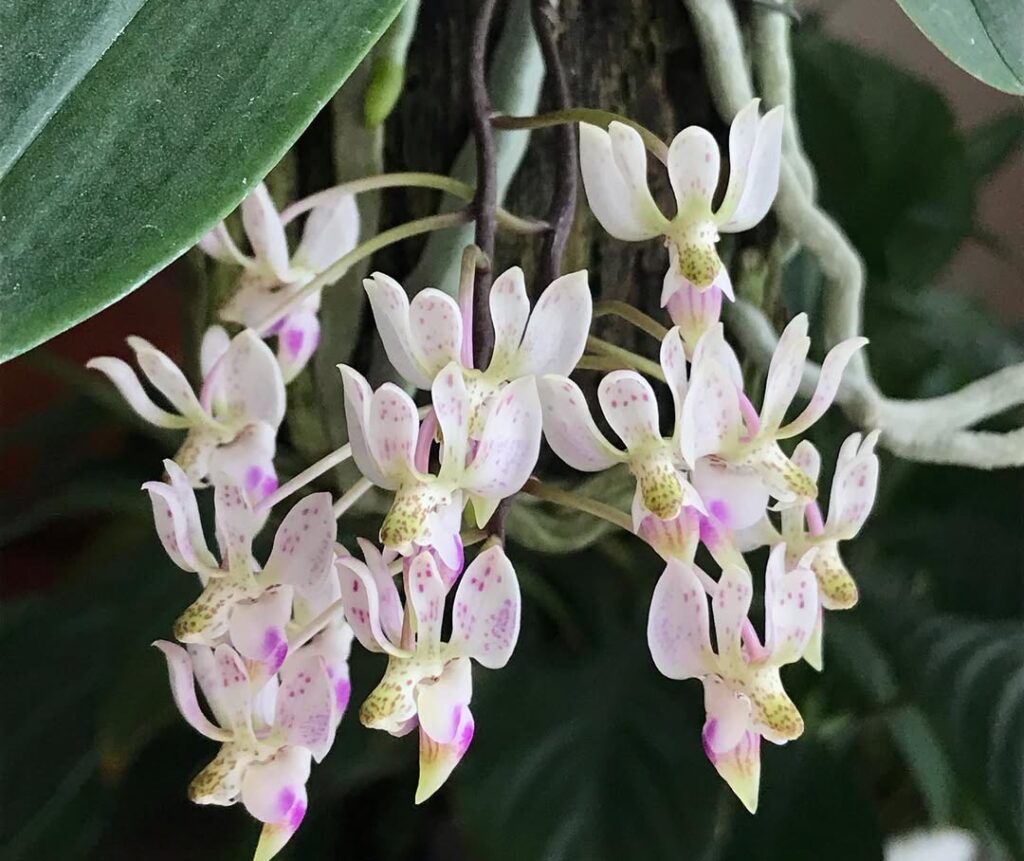
- 1 Timetable for Phalaenopsis finleyi Care
- 2 1. Essential Care for Phalaenopsis finleyi
- 3 2. Care After Flowering
- 4 3. Types of Phalaenopsis finleyi
- 5 4. Pruning for Healthy Growth
- 6 5. Propagating Phalaenopsis finleyi
- 7 6. Potting and Repotting
- 8 7 Blooming: How to Encourage Thriving Flowers
- 9 8. Pests & Diseases: Protecting Your Orchid
- 10 9. Common Issues and How to Solve Them
- 11 How to Mount Phalaenopsis finleyi (Phalaenopsis minus) for Optimal Growth
- 12 FAQS
Timetable for Phalaenopsis finleyi Care
| Growth Stage | Care Task | Best Time |
|---|---|---|
| Dormancy (Winter) | Reduce watering, provide bright light | Late Fall – Early Spring |
| Active Growth (Spring – Summer) | Increase watering, fertilize every 2 weeks | Mid-Spring – Late Summer |
| Flowering Period | Maintain high humidity, stable temperatures | Late Summer – Fall |
| Post-Flowering Care | Cut spent spikes, adjust watering | Early Winter |
1. Essential Care for Phalaenopsis finleyi
Caring for Phalaenopsis finleyi requires a shift in mindset from conventional orchid care. Because this orchid does not have leaves, its roots play a dual role in absorbing both moisture and light. Unlike other orchids that do well in pots with bark or sphagnum moss, Phalaenopsis finleyi thrives best when mounted on cork, driftwood, or tree fern fiber. This allows its roots to remain exposed, ensuring they can photosynthesize effectively.
Light is one of the most crucial factors for this orchid. It requires bright, indirect light, ideally around 2,000–3,000 foot-candles. If grown indoors, placing it near an east or south-facing window with sheer curtains works well. Too much direct sunlight can burn the roots, while insufficient light may lead to weak growth and failure to bloom. If natural light is inconsistent, using a full-spectrum LED grow light can supplement the required brightness.
Watering should be carefully managed. Unlike traditional orchids that store moisture in their pseudobulbs or leaves, Phalaenopsis finleyi relies solely on its roots for hydration. Daily misting during the growing season is ideal, but the roots should dry out between waterings to prevent fungal infections. During the winter dormancy period, watering should be reduced significantly to avoid rot.
Maintaining high humidity levels (around 60–80%) is essential for this orchid to thrive. A humidity tray, frequent misting, or even placing the plant in a greenhouse or terrarium can help achieve this. However, good air circulation must be ensured to prevent fungal issues.
Expert Tip:
If you notice the roots turning a dull grayish color, it’s a sign they need more water. Healthy roots should appear bright green or silvery-white when dry.
2. Care After Flowering
Once Phalaenopsis finleyi finishes blooming, it enters a brief dormancy phase. Many growers make the mistake of continuing to water and fertilize as they did during the flowering stage, which can lead to stress and poor growth in the next cycle. To properly care for your orchid after flowering, you should gradually reduce watering and stop fertilizing until new growth appears in spring.
Spent flower spikes should be trimmed off at the base using sterilized scissors. This allows the plant to redirect energy to root development rather than trying to sustain old flower stems. It’s also a good time to inspect the roots and remove any that appear shriveled, dry, or rotting.
Temperature stability is critical during this period. While Phalaenopsis finleyi can tolerate slight fluctuations, keeping it in a warm environment (70–85°F during the day and slightly cooler at night) will promote a healthy recovery. Avoid drastic changes in its environment, as this can cause unnecessary stress.
Expert Tip:
If your orchid’s roots look dehydrated after flowering, mist them lightly rather than soaking them, as excessive moisture during dormancy can lead to root rot.
3. Types of Phalaenopsis finleyi
Phalaenopsis finleyi is a species orchid, meaning it is not a hybrid but a naturally occurring variety. While there are no officially recognized subspecies, different environmental conditions can lead to slight variations in root appearance and flower coloration.
In warmer conditions, the flowers tend to display a deeper yellow-green hue, while cooler temperatures may result in paler blooms. Some specimens also exhibit slight differences in petal shape and size, depending on their growing conditions.
Expert Tip:
If you want to bring out the most vibrant flower colors in Phalaenopsis finleyi, ensure it receives adequate light and a slight temperature drop at night during the pre-blooming stage.
4. Pruning for Healthy Growth
Pruning plays a limited but essential role in keeping Phalaenopsis finleyi healthy. Since this orchid lacks leaves, the primary focus should be on maintaining root health. Dead, dry, or damaged roots should be carefully trimmed with sterilized scissors to prevent infections.
Once the orchid has finished blooming, the old flower spike can be cut at the base. Leaving spent spikes in place can waste the plant’s energy. However, be careful not to cut any roots, as they are crucial for the orchid’s survival.
Expert Tip:
Always sterilize your cutting tools with rubbing alcohol or a flame before pruning to prevent the spread of bacteria and fungi.
5. Propagating Phalaenopsis finleyi
Unlike some orchids that readily produce keikis (baby plants), Phalaenopsis finleyi is more challenging to propagate. The most viable method is seed propagation, which requires a sterile environment and specialized nutrient media.
Since the plant does not produce pseudobulbs or offshoots, dividing it is not possible. Instead, seeds must be germinated in flasks under laboratory conditions. This process can take years, making it a method best left to experienced growers or professional orchid breeders.
Expert Tip:
If you are interested in propagating Phalaenopsis finleyi, consider sourcing flasked seedlings from reputable orchid nurseries instead of attempting seed germination yourself.
6. Potting and Repotting
Since Phalaenopsis finleyi thrives best when mounted, traditional potting methods are unsuitable. The orchid should be securely attached to a piece of cork, driftwood, or tree fern fiber using sphagnum moss and soft ties until its roots naturally grip the surface.
Repotting is generally unnecessary unless the mounting material deteriorates, which usually happens every 3–4 years. If the roots start outgrowing the mount, they can be gently repositioned without cutting or damaging them.
7 Blooming: How to Encourage Thriving Flowers
One of the most rewarding aspects of growing Phalaenopsis finleyi is seeing its delicate flowers emerge. However, achieving consistent blooms requires precise environmental conditions. This orchid typically flowers in late summer to early fall, producing small, fragrant yellow-green blooms along thin spikes.
To encourage blooming, Phalaenopsis finleyi needs a distinct temperature drop at night. A difference of about 10°F (5°C) between day and night temperatures triggers the flowering process. Ideally, daytime temperatures should be between 75–85°F (24–29°C) and nighttime temperatures around 60–65°F (15–18°C).
Light exposure is another critical factor. If your orchid is receiving enough bright, indirect light (around 2,000–3,000 foot-candles), it is more likely to produce flowers. If the orchid has not bloomed for more than a year, insufficient light is usually the culprit.It may benefit from being moved to a brighter area or enhanced with grow lights.
Fertilization should also be adjusted to support flowering. Switching to a bloom booster fertilizer (high in phosphorus, like 10-30-20) in the months leading up to the blooming season will encourage spike formation. However, fertilizing should be reduced once the flowers start to open to prevent excess nutrient buildup.
Expert Tip:
If your Phalaenopsis finleyi is not blooming despite proper care, slightly reducing watering and increasing light exposure can stress the plant just enough to encourage flowering.
8. Pests & Diseases: Protecting Your Orchid
Despite its unique growth habit, Phalaenopsis finleyi is still susceptible to common orchid pests and diseases. The most frequent invaders include spider mites, mealybugs, scale insects, and thrips. Because this orchid has no leaves, pests often target the exposed roots, making infestations harder to detect.
Regularly inspecting the roots is essential. If you notice small white cotton-like masses (mealybugs) or tiny moving dots (spider mites), treatment should begin immediately. Spraying the roots with a diluted neem oil solution or insecticidal soap can effectively eliminate most pests.
Fungal and bacterial infections can also develop if humidity is too high without proper airflow. Blackened, mushy roots indicate root rot, which can spread rapidly if left untreated. If root rot is detected, the affected roots should be trimmed with sterilized scissors, and the remaining healthy roots treated with a fungicide.
Expert Tip:
To prevent pests, mist your orchid with a diluted neem oil spray once a month, especially if you keep multiple orchids together, as pests can spread quickly between plants.
9. Common Issues and How to Solve Them
Even with proper care, issues can arise when growing Phalaenopsis finleyi.Some frequent issues and solutions are listed below.
Problem 1: Roots Are Drying Out Too Fast
Cause: Low humidity, excessive heat, or under-watering.
Solution: Increase humidity using a humidity tray or regular misting. If the environment is too dry, consider placing the orchid in a greenhouse or terrarium to maintain stable moisture levels.
Problem 2: No Flowers or Delayed Blooming
Cause: Insufficient light, inconsistent temperatures, or over-fertilization.
Solution: Move the orchid to a brighter location, ensure a 10°F (5°C) temperature drop at night, and switch to a bloom-specific fertilizer.
Problem 3: Root Rot or Fungal Infection
Cause: Overwatering, poor air circulation, or stagnant humidity.
Solution: Remove affected roots, apply a fungicide, and improve airflow around the orchid. Reduce watering and allow roots to dry completely between misting.
Problem 4: Pests on the Roots
Cause: Infestation of spider mites, mealybugs, or scale insects.
Solution: Treat with neem oil spray or insecticidal soap, and quarantine the affected orchid if other plants are nearby.
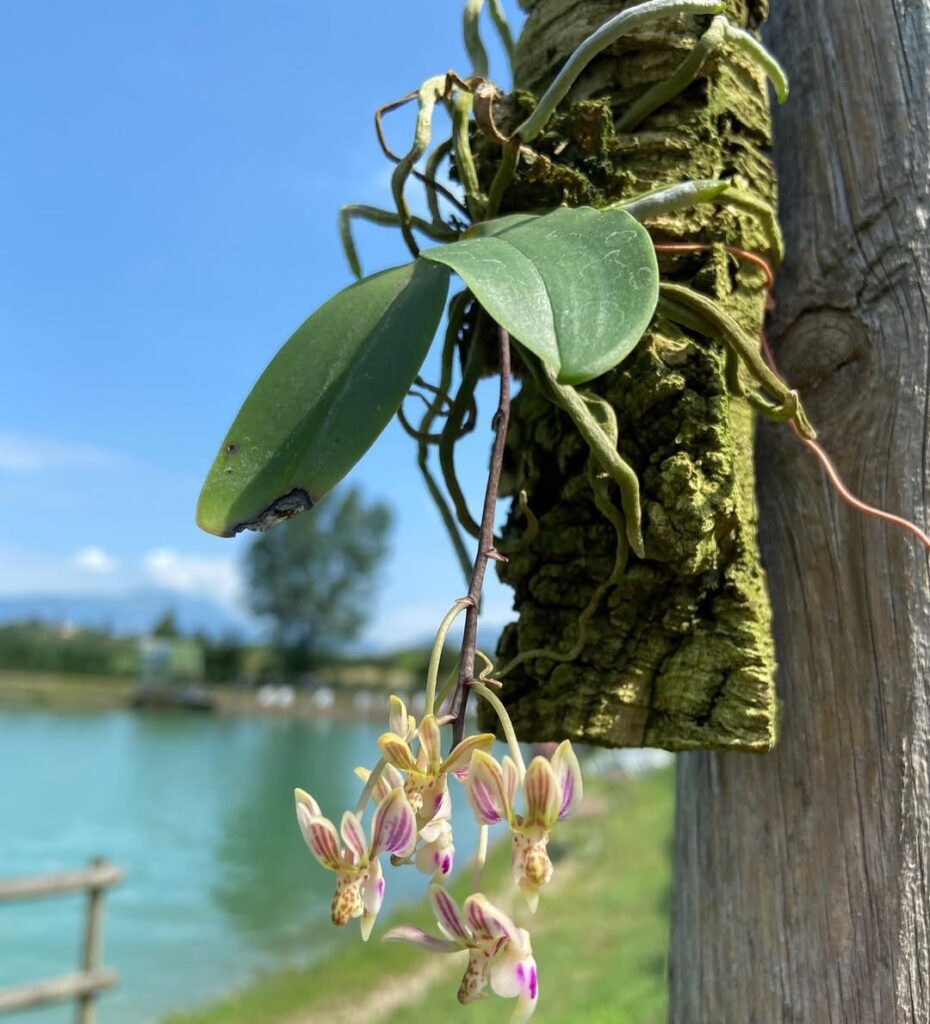
How to Mount Phalaenopsis finleyi (Phalaenopsis minus) for Optimal Growth
Phalaenopsis finleyi, also known as Phalaenopsis minus, is a miniature, warm-growing orchid that thrives when mounted. Since it naturally grows on trees in the wild, mounting it mimics its natural habitat, promoting healthy root growth and proper air circulation. Here’s how you can successfully mount your Phalaenopsis finleyi:
1. Choose the Right Mounting Material
Cork bark – Ideal for orchids, providing a rough surface for roots to grip.
Tree fern slabs – Retains moisture well while allowing airflow.
Hardwood branches – Mimic natural tree branches, excellent for epiphytic orchids.
2. Prepare the Orchid
If your Phalaenopsis finleyi is potted, gently remove it from the pot and shake off any loose media.
Use sterilised scissors to cut off any dead or decaying roots.
Soak the orchid and the mount in water for 30 minutes to increase flexibility and moisture retention.
3. Position the Orchid on the Mount
Place the orchid at an angle to prevent water from accumulating at the base.
Spread the roots across the mounting surface to encourage attachment.
Avoid placing the crown too close to the mount to prevent rot.
4. Secure the Orchid
Use fishing line, soft wire, or natural jute twine to attach the roots to the mount without constricting them.
Gently wrap sphagnum moss around the roots (optional) to maintain initial humidity, especially in drier environments.
5. Provide the Right Growing Conditions
Light: Bright, indirect light or dappled sunlight. Avoid harsh direct sun.
Humidity: 50–80% is ideal. Mist regularly or grow in a humid environment.
Watering: Water daily in warm weather and reduce in winter. Since it’s mounted, it will dry out faster than potted orchids.
Air Circulation: Good air movement is crucial to prevent rot.
6. Allow the Orchid to Establish
Over time, roots will attach firmly to the mount.
If using moss, reduce it gradually as the plant adjusts.
Once established, Phalaenopsis finleyi will reward you with stunning small flowers and a natural, aesthetic display.
Problem 5: Yellowing or Weak Growth
Cause: Lack of nutrients, too much shade, or improper mounting.
Solution: Adjust fertilization routine, provide more light, and ensure the orchid is mounted on a suitable surface for root attachment.
Expert Tip:
If your Phalaenopsis finleyi is struggling, keeping a care journal can help identify patterns in watering, light exposure, and environmental conditions, making it easier to pinpoint problems and solutions.
Final Thoughts: Mastering Phalaenopsis finleyi Care
Growing Phalaenopsis finleyi is a rewarding challenge that requires a different approach from traditional orchids. Since it relies entirely on its roots for photosynthesis and hydration, proper mounting, light exposure, humidity, and temperature control are crucial. By following these expert tips, you can cultivate a thriving, blooming orchid that stands out in any collection.
FAQS
What is Phalaenopsis finleyi?
Phalaenopsis finleyi is a unique miniature orchid species known for its small size, fragrant flowers, and ability to thrive in warm, humid conditions. It was previously classified under the genus Kingidium but is now recognized as a Phalaenopsis species.
How do I care for Phalaenopsis finleyi?
To care for Phalaenopsis finleyi, provide bright, indirect light, maintain temperatures between 65–85°F (18–29°C), and ensure high humidity levels of 60–80%. Water it frequently but allow the roots to dry slightly between waterings.
Does Phalaenopsis finleyi need special potting media?
Yes, Phalaenopsis finleyi thrives in a well-draining medium like sphagnum moss, bark, or a mix of both. Many growers prefer mounting it on cork or wood slabs to mimic its natural habitat.
How often should I water Phalaenopsis finleyi?
Phalaenopsis finleyi should be watered 2–3 times per week, depending on humidity and airflow. If mounted, it may require daily misting to prevent dehydration.
Does Phalaenopsis finleyi require high humidity?
Yes, Phalaenopsis finleyi thrives in 60–80% humidity. If your home has low humidity, consider using a humidity tray, misting the plant regularly, or using a small humidifier.
When does Phalaenopsis finleyi bloom?
Phalaenopsis finleyi typically blooms in late spring to summer, producing small, star-shaped flowers with a sweet fragrance. Proper care and lighting encourage regular blooming

